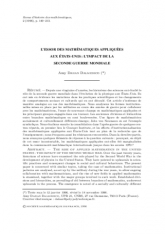L'essor des mathématiques appliquées aux États-Unis : l'impact de la seconde guerre mondiale
The rise of applied mathematics in the United States : the impact of the second world war

- Consulter un extrait
- Année : 1996
- Fascicule : 2
- Tome : 2
- Format : Électronique
- Langue de l'ouvrage :
Français - Pages : 149-213
- DOI : 10.24033/rhm.55
Depuis une vingtaine d'années, les historiens des sciences ont étudié le rôle de la seconde guerre mondiale dans l'évolution de la physique aux États-Unis. Ils ont mis en évidence les mutations dans les pratiques scientifiques et les changements de comportements sociaux et culturels qui en ont découlé. Cet article s'intéresse de manière analogue au cas des mathématiques. Nous analysons les formes institutionnelles mises en place par les militaires au cours des années de guerre pour collaborer avec les mathématiciens, l'essor de nouveaux champs en mathématiques appliquées et les principaux groupes engagés dans ces travaux. Les anciennes divisions et hiérarchies entre branches mathématiques en sont bouleversées. Une figure de mathématicien socialement et culturellement différente émerge ; John von Neumann en est l'exemple symbolique. Nous étudions ensuite la consolidation dans l'après-guerre de quelques centres réputés, en premier lieu le Courant Institute, et les efforts d'institutionnalisation des mathématiques appliquées aux États-Unis tant au plan de la recherche que de l'enseignement ; nous évoquons aussi les résistances rencontrées. Dans la dernière partie, nous avançons quelques éléments de réponse à la question suivante : pourquoi, en dépit de cet essor incontestable, les mathématiques appliquées ont-elles été marginalisées dans la communauté mathématique internationale jusque dans les années 1970 ?

